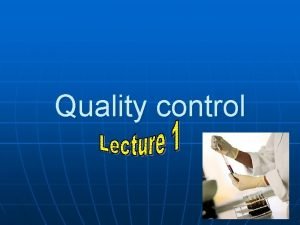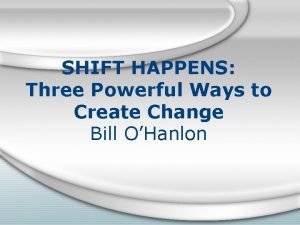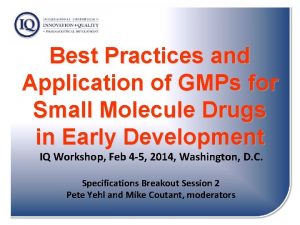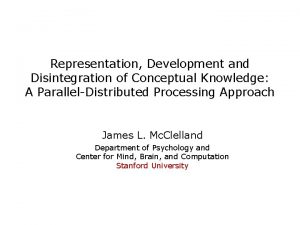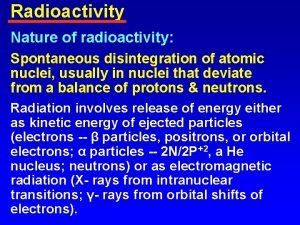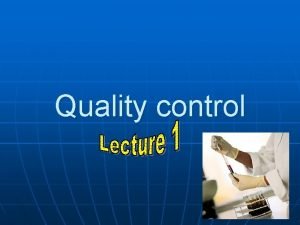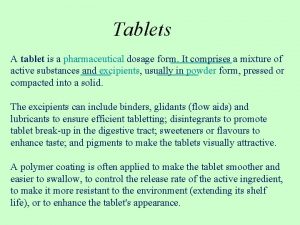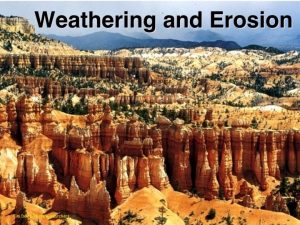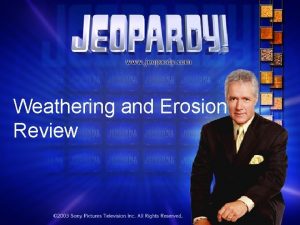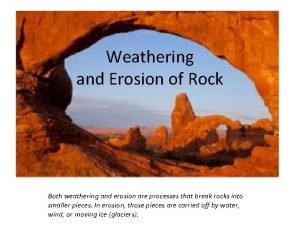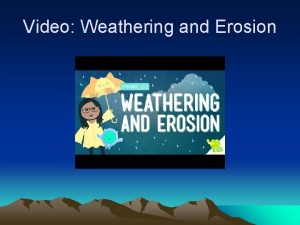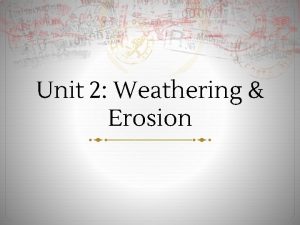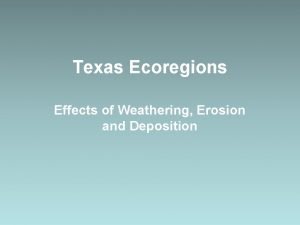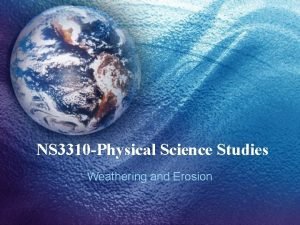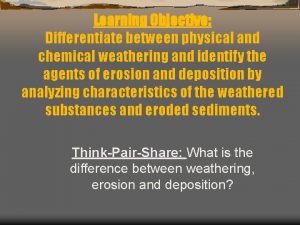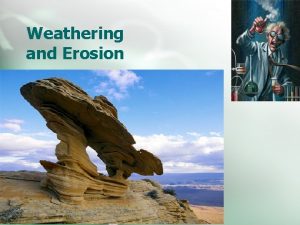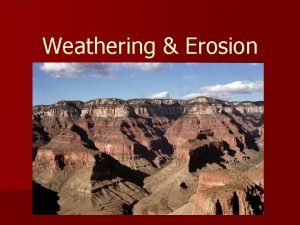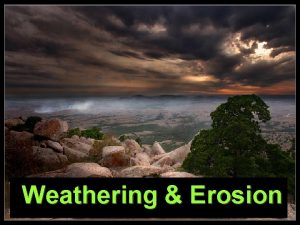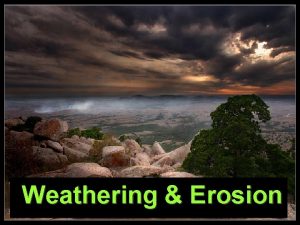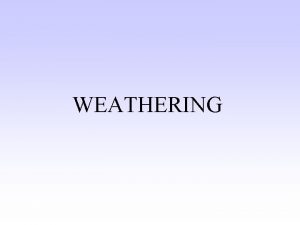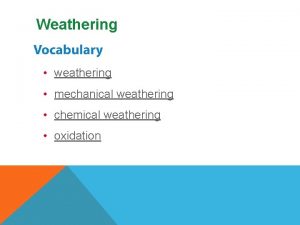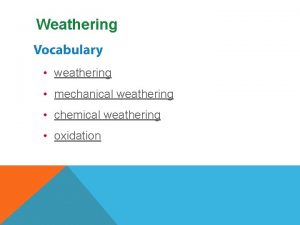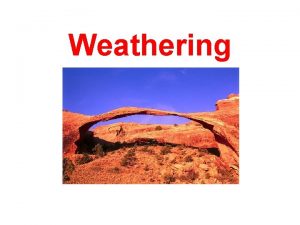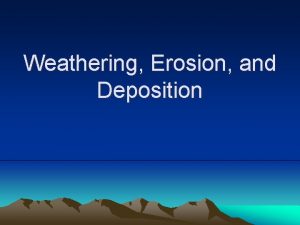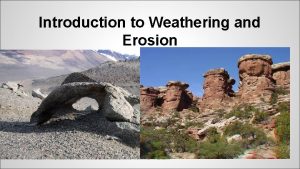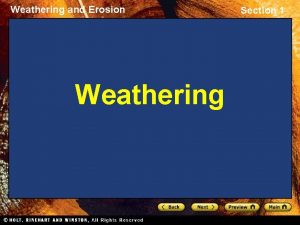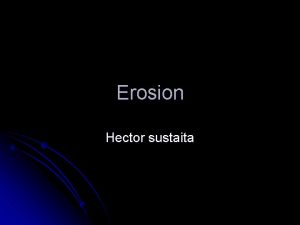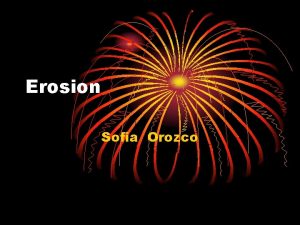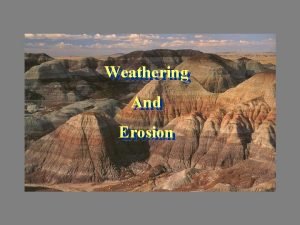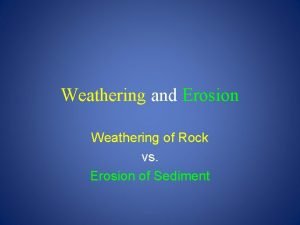Weathering and Erosion Weathering and Erosion Weathering Disintegration



















- Slides: 19

Weathering and Erosion

Weathering and Erosion Weathering- Disintegration and decomposition of rock at or near the earth’s surface. Mechanical Chemical Erosion- Incorporation and transportation of material by a mobile agent, usually water, wind or ice. Mass wasting (or the transfer of rock material down slope under the influence of gravity) is one of the biggest factors in the cause of erosion.

Mechanical Weathering Frost wedging- Freezing and thawing of water causes weathering Because water expands about 9 percent when frozen. water works its way into cracks of a rock, and then freezes causing the expand water to push out of the rock. Biological Activity- weathering is also caused by activities of organisms like, plants, burrowing animals, and human activity, even decaying organisms produce acids that contribute to weathering. Thermal Expansion- Heating a rock causes it to expand while cooling causes it to contract. This process of expanding and contracting from the daily cycle of temperature is called thermal expansion.

Chemical weathering Involves complex processes that alter the internal structures of minerals by removing and/ or adding elements. Water in the most important part of chemical weathering. Alone pure water in nonreactive but small amounts of dissolved material is all that is needed for chemical weathering to occur. Silicate minerals- The earths crust is mostly made up of silicate minerals. When chemical weathered silicate minerals yield sodium calcium potassium and magnesium ions. These form soluble products that may be removed by groundwater. Carbon dioxide- When carbon dioxide dissolves in water it forms carbonic acid. Rain dissolves some carbon dioxide as it falls through the atmosphere and additional amounts are dissolved from decaying organic matter as water percolates through the soil.

What is Erosion and Deposition

What is erosion and Deposition? Erosion Is the removal of loosened rock pieces from a higher elevation to a lower point with the action of natural agents. Deposition is when the process of erosion ends and transported particles settle on the surface.

How dose gravity help erosion? The energy of erosion comes from several sources. Gravity acts to vertically move materials of higher relief to lower elevations to produce an equilibrium. It also acts on the mediums of erosion to cause them to flow to base level.

What is the difference between erosion and deposition? Erosion is when the water is eroding away the bank causing it to get wider and wider over the years. Deposition is the build up of sediments of organically derived matter or chemical processes

Earth Subsystems

Everything in Earth’s system can be placed into one of four major subsystems: Land, Water, Living things, or air. These four subsystems are called “Spheres. ” Specifically they are • *Lithosphere- Land( Test question) • Hydrosphere- Water • Biosphere -Living things • Atmosphere-Air

Lithosphere contains all of the cold, hard solid land of the planet’s crust (surface), the semisolid land underneath the crust, and the liquid land near the center of the planet. The surface of the lithosphere is very uneven. There are high mountain ranges like the Rockies and Andes, huge plains or flat areas like those in Texas, Iowa, and Brazil, and deep valleys along the ocean floor.

Hydrosphere contains all the solid, liquid, and gaseous water of the planet. It ranges from 10 to 20 kilometers in thickness. The hydrosphere extends from Earth’s surface downward several kilometers into the lithosphere and upward about 12 kilometers into the atmosphere. A small portion of the water in the hydrosphere is fresh (non-salty) This water flows as precipitation from the atmosphere down to Earth’s surface, as rivers and strams along Earth’s surface, and as ground water beneath Earth’s surface. Most of Earth’s fresh water is frozen. 97% of Eath’s water is salty. The salty water collects in deep valleys along Earth’s surface.

Biosphere contains all the planet’s living things. This sphere includes all of the microorganisms, plants, and animals of Earth. Within the biosphere, living things form ecological communities based on the physical surroundings of an area. These communities are call biomes. Deserts, grasslands, and tropical rainforests are three of the many types of biomes that exist within the biosphere. Atmosphere contains all the air in the Earth’s systems. The upper portion of the atmosphere protects the organisms of the biosphere from the sun’s ultraviolet radiation. It also absorbs and emits heat. When air temperature in the lower portion of this sphere changes, weather occurs. As air in the lower atmosphere is heated or cooled, it moves around the planet. The result can be as simple as a breeze or as complex as a tornado.

*There are minerals found in water like iron, sulfate, sodium, chloride and fluoride. Also there are minerals found in rocks. A mineral can be any substance found in the earth. For example aluminum is the third most abundant mineral in Earth’s crust.

Affect of surface and ground water

How our use and gathering of energy, minerals, and rock resources from the earth affect earth. Ways resources are gathered. • Fracking (Fracturing or Hydrofracing) • Mining

The Affects of Fracking, How does it Work? How Does Fracking Work? First, a hole is drilled into reservoir shale rock formations. Next, a mixture of water and chemicals is injected at a very high pressure, and this causes gas to flow out for collection or leaching There are several chemicals used in fracturing. Al hy so k fra dra now hy ctu ulic n a s dr rin ofr g ac or ing ally ed c i em forc t h c of d are nd le s lon san ock a l a of g r and eak r s lion wate to br. l i M ted nd flow u a o e tr ergr apor und ped v trap Injec ti rock ng water h a earth as cause nd chem ic d q were uakes. A several als into s do h lt m haza inor, the hough th cumente ale es rd wh y d ereve will alwa e earthq ua ys be r frac king a pot kes takes e place ntial.

Mining Super important What is min Mining is ing? th minerals e extraction (re m and met als from oval) of Mangan earth. ese tin, nicke , tantalum, cas siterite, l, a copper, silver, an luminum ore, ir on ore, g d ol of exam diamonds. That ’s only a d, ples of w handful hats min ed for. the ) r e t s u te (cl a such m a s l g l a a c i ury. hem to am c c r r e e e s d m r u l In o , they y, or methy s n o i t ilings a t extrac de, mercur h g i throu ged into n a o y g c s l as char mica s e his i h d T c. n s e e n t s f a e Th are o d oce d n n a a , ) s (pipes treams, bay living r. l l a s s te wate f rivers, contamina o y d on e bo h t n i h polluti s wit m s i n a org Land dregging: involves miners using a generator to dig a large hole in the ground. They use a high pressure hose to expose the gold-bearing layer of sand clay. The gold bearing slurry is pumped into a sluice box, which collects gold particles, while mine tailings flow into either an abandoned mining pit or adjacent forest. When the mining pits fill with water from the tailings, they become stagnant water pools. These pools create a breeding ground for mosquitoes and other waterborn insects. Malaria and other water-born diseases increase significantly whenever open pools of water are nearby. None of these practices do anything to help the environment or recharge it

Citations http: //kids. mongabay. com/lesson_plans/lis a_algee/mining. html http: //earthday 2012. com/what-is-frackingwhy-ban-fracking/
 Content uniformity definition
Content uniformity definition Theory of positive disintegration
Theory of positive disintegration Theory of positive disintegration
Theory of positive disintegration Dissolution vs disintegration
Dissolution vs disintegration Temporal pole function
Temporal pole function Radioactivity as spontaneous disintegration
Radioactivity as spontaneous disintegration Compendial testing definition
Compendial testing definition Sugar coated tablet example
Sugar coated tablet example Erosion types
Erosion types Piney woods weathering erosion and deposition
Piney woods weathering erosion and deposition What is the difference between weathering and erosion?
What is the difference between weathering and erosion? Double jeopardy
Double jeopardy Erosion video bill nye
Erosion video bill nye Exfoliation definition weathering
Exfoliation definition weathering Weathering and erosion difference youtube video
Weathering and erosion difference youtube video Weathering and erosion questions
Weathering and erosion questions Piney woods
Piney woods Rolling plains weathering
Rolling plains weathering Weathering
Weathering Differentiate between chemical and physical weathering.
Differentiate between chemical and physical weathering.
